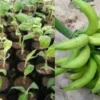- このトピックは空です。
- 投稿者投稿
- 3月 31, 2025 6:49 am #615319
Sida acuta, commonly known as the “pointed-leaf sida,” is a tropical and subtropical weed that has gained significant attention in agricultural settings. Its rapid growth and invasive nature have made it a challenging problem for farmers worldwide.
As a weed in agriculture, Sida acuta competes with crops for resources such as nutrients, water, and sunlight, often diminishing crop yields and causing long-term ecological imbalances.
This article explores the impact of Sida acuta as a weed in agriculture, examining its characteristics, effects on crops, control methods, and the overall consequences for farmers.
1. Characteristics of Sida Acuta as a Weed
Sida acuta is a perennial herbaceous plant that grows prolifically in disturbed soils and thrives in various climatic conditions. It is known for its ability to rapidly spread through seeds and vegetative growth, which allows it to dominate fields quickly.
The plant can reach up to 1.5 meters in height, with broad, pointed leaves and yellow flowers. Its seeds are dispersed by wind and animals, contributing to its spread in agricultural areas. The rapid growth and reproduction of Sida acuta make it a persistent threat to crop production.
2. Impact on Crop Yields and Agricultural Practices
Sida acuta has a direct negative impact on agricultural productivity. By competing with crops for essential resources, this weed reduces the availability of nutrients and water, which are crucial for healthy plant growth.
As a result, crops may become stunted, with reduced growth rates and poor-quality produce. Furthermore, Sida acuta can harbor pests and diseases that may spread to crops, exacerbating the problem.
Its dense growth also makes it difficult for farmers to access their crops, complicating harvesting processes and increasing labor costs.
3. Methods of Controlling Sida Acuta in Agricultural Fields
Managing Sida acuta as a weed in agricultural fields requires a combination of mechanical, chemical, and cultural control strategies. Farmers often use herbicides to control its spread, although over-reliance on chemicals can lead to resistance over time.
Mechanical control involves manually removing the plant or mowing it before it reaches maturity, which can prevent seed dispersal.
Additionally, crop rotation and the use of cover crops can help suppress the growth of Sida acuta by altering the environment to make it less favorable for the weed. Integrated pest management (IPM) strategies, which combine multiple approaches, have proven effective in managing Sida acuta in sustainable farming practices.
4. Ecological and Economic Consequences of Sida Acuta Infestation
The infestation of Sida acuta in agricultural areas has both ecological and economic consequences. Ecologically, the weed can alter the local habitat by outcompeting native plants and disrupting biodiversity.
Its dense growth can also lead to soil degradation by altering the balance of nutrients. Economically, the presence of Sida acuta reduces crop yields, leading to financial losses for farmers.
Moreover, the cost of controlling the weed—through labor, herbicides, and machinery—adds further financial strain, especially for small-scale farmers who lack the resources for extensive weed management.
5. Future Prospects for Managing Sida Acuta in Agriculture
Looking ahead, researchers and agricultural experts are exploring more sustainable and effective methods for managing Sida acuta as a weed. The development of resistant crop varieties and the use of biological control agents are being investigated as potential solutions.
Biological control could involve introducing natural predators or pathogens that target the weed, offering a more environmentally friendly alternative to chemical herbicides.
Additionally, increasing awareness and educating farmers about the best practices for managing Sida acuta can help mitigate its spread and reduce its impact on agricultural systems.
In conclusion, Sida acuta has emerged as a formidable weed in agriculture, posing significant challenges to crop production and farm management. Its invasive nature and ability to compete with crops for vital resources make it a persistent problem.
While various control measures are in place, ongoing research and the adoption of integrated management strategies will be crucial in minimizing its impact. As agricultural practices evolve, finding sustainable and effective solutions for controlling Sida acuta will help protect crop yields and ensure long-term agricultural productivity.
- 投稿者投稿
- このトピックに返信するにはログインが必要です。





